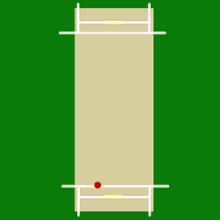Leg spin is a type of spin bowling in the sport of cricket. A leg spinner bowls right-arm with a wrist spin action, causing the ball to spin from right to left in the cricket pitch, at the point of delivery. When the ball bounces, the spin causes the ball to deviate sharply from right to left, that is, away from the leg side of a right-handed batsman. The same bowling action when performed by a left-arm bowler is known as left-arm unorthodox spin bowling.
As with all spinners, leg spinners bowl the ball far slower (70–90 km/h or 45-55 mph) than fast bowlers. The fastest leg spinners will sometimes top 100 km/h (60 mph). Leg spinners typically use variations of flight by sometimes looping the ball in the air, allowing any cross-breeze and the aerodynamic effects of the spinning ball to cause the ball to dip and drift before bouncing and spinning (usually called "turning") sharply. While very difficult to bowl accurately, good leg spin is considered one of the most threatening types of bowling to bat against, since the flight and sharp turn make the ball's movement extremely hard to read and the turn away from the batsman (assuming he or she is right-handed) is more dangerous than the turn into the batsman generated by an off spinner.
Highly skilled leg spin bowlers are also able to bowl deliveries that behave unexpectedly, including the googly, which turns the opposite way to a normal leg break and the topspinner, which doesn't turn but dips sharply and bounces higher than other deliveries. A few leg spinners such as Anil Kumble, Shane Warne, John Lister, Mushtaq Ahmed, and Imran Tahir have also mastered the flipper, a delivery that like a topspinner goes straight on landing, but floats through the air before skidding and keeping low, often dismissing batsmen leg before wicket or bowled. Another variation in the arsenal of some leg spinners is the slider, a leg break pushed out of the hand somewhat faster, so that it doesn't spin as much, but travels more straight on.
To grip the ball for a leg-spinning delivery, the ball is placed into the palm with the seam parallel to the palm. The first two fingers then spread and grip the ball, and the third and fourth fingers close together and rest against the side of the ball. The first bend of the third finger should grasp the seam. The thumb resting against the side is up to the bowler, but should impart no pressure. When the ball is bowled, the third finger will apply most of the spin. The wrist is cocked as it comes down by the hip, and the wrist moves sharply from right to left as the ball is released, adding more spin. The ball is tossed up to provide flight. The batsman will see the hand with the palm facing towards them when the ball is released.
 It may be one of the most difficult skills to master in cricket, but a good leg spinner will almost certainly get plenty of wickets. Leg spin involves turning a ball off the pitch from the leg-side of a right-handed batsman, to the off-side. It is often described as wrist spin because, unlike off spinners, the revolutions of the ball are generated by the wrist rather than the fingers. STEP ONE The top joints of the index and middle fingers are across the seam, with the ball resting between a bent third finger and the thumb. STEP TWO As you release the ball, straighten the fingers and much of the work on the ball will be done by the third finger, turning the ball anti-clockwise. Flick the wrist so that the palm of the hand finishes facing downwards. |
